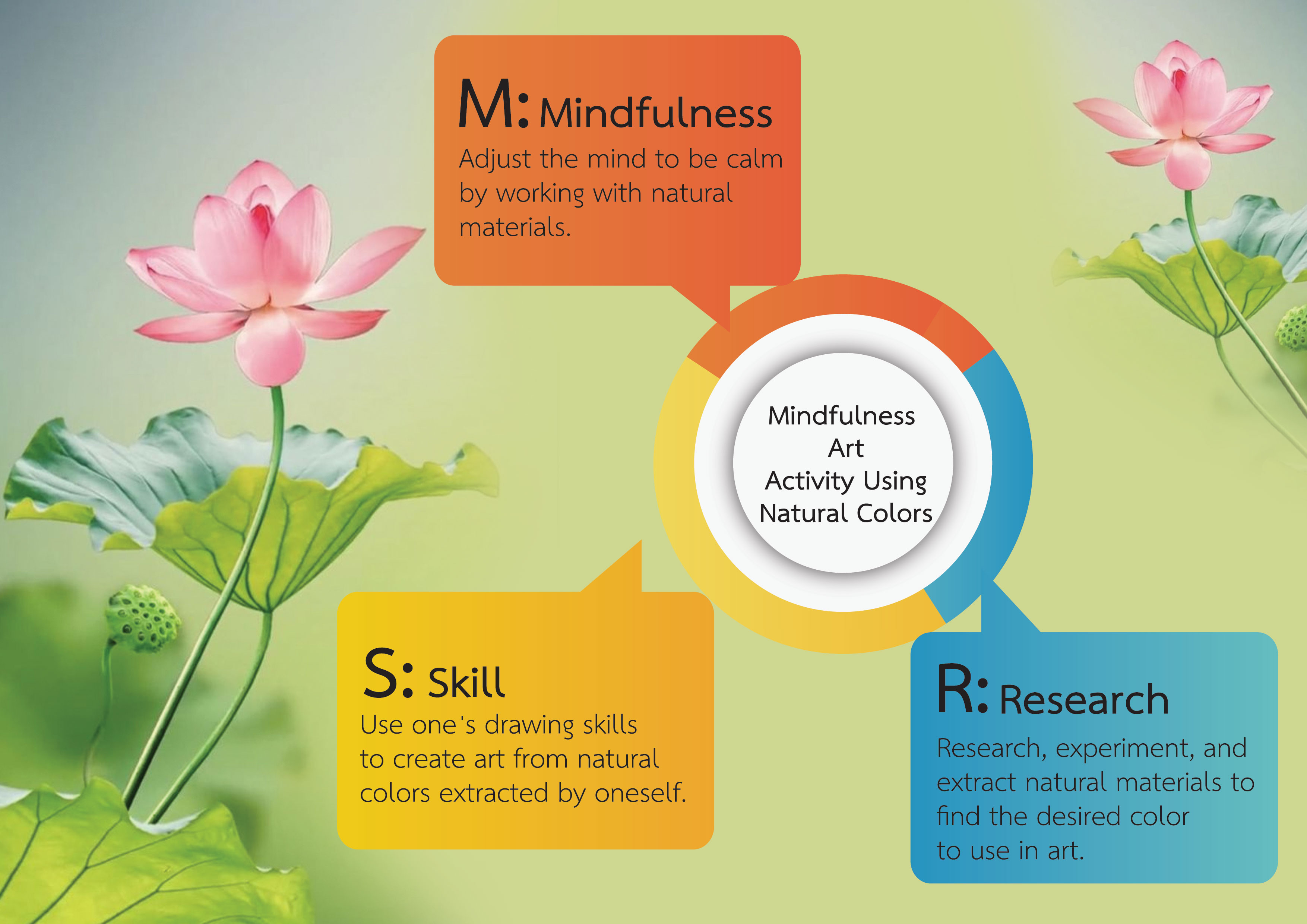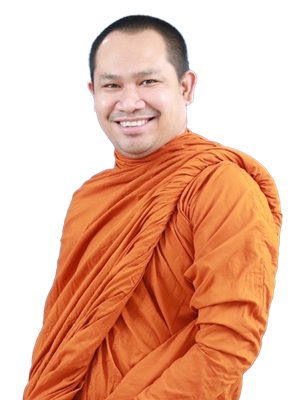MINDFULNESS ART FROM NATURAL COLORS
Keywords:
Mindfulness, Art, Natural ColorsAbstract
Background and Objectives: In recent years, the use of natural colors has become one of the popular options for artists and art educators. Working with nature helped adjust the mind to be calm and concentrated. Pigments extracted from nature were not only safe for the body and the environment but also sustainable materials readily available from local areas. Thus, the objectives of this research article were to study and analyze processes for extracting natural colors for use in art creation and art activities and to present guidelines for organizing mindfulness art activities using colors extracted from natural materials.
Methodology: This research was a systematic review. Data were analyzed from 24 selected research articles, which were categorized into four main issues: 1) The extraction of natural colors for art creation; 2) The use of natural colors in art activities; 3) Art for mindfulness; and 4) Natural colors and mindfulness. The tools used in this research included: 1) A research quality assessment form related to the topic studied and criteria for evaluating research quality; and 2) A data recording form consisting of general information about the research, such as the name of the author, year of publication, sample group, research methods, and research results.
Main Results: 1) The research findings indicated that art activities using natural colors enhanced mindfulness and 2) A guideline for organizing Mindfulness Art Activities from Natural Colors (MAANC Model) was proposed, which consisted of Mindfulness: Adjusting the mind to be calm by engaging with nature and natural materials, allowing the mind to become meditative; Research: Extracting and experimenting with natural materials to find the desired colors for use in art; Skill: Utilizing artistic skills to create art from natural colors extracted independently.
Involvement to Buddhadhamma: The results of this research were categorized as Applied Buddhism, representing the integration of Buddhism with modern or contemporary knowledge. This work fell within the realm of Buddhism and the development of wisdom and morality.
The purpose was to present guidelines for organizing mindfulness art activities using natural colors. These activities combined art creation with meditation, using nature as a medium to achieve concentration and peace. Physiological responses to being in a natural environment, such as decreased heart rate, were observed, contributing to mental rejuvenation, improved concentration, and a deeper sense of connection. The processes involved in making art, from extracting colors to experimenting with and applying them, aligned with the Dhamma principles of the Four Iddhipada (Four Paths of Accomplishment): 1) Chanda (Passion) The satisfaction of exploring and experimenting with creating art from natural materials; 2) Viriya (Diligence) The perseverance to work on art with dedication until its completion; 3) Citta (Mindfulness or Consciousness) The focused intention to research, experiment, and extract colors for the artwork; and 4) Vimamsa (Investigation) The effort to evaluate, plan, examine, and improve the artwork for optimal results.
Conclusions: Humans were inherently connected to nature. Working with natural materials brought them closer to their origin, evoking feelings of comfort and belonging. This connection fostered Chanda (Passion), which supported other creation processes until completion.
Working with natural colors demonstrated a tendency to calm the mind. Furthermore, art activities using natural colors positively influenced meditation, promoting mindfulness and mental clarity.
References
Bureekhampun, S. & Maneepun, C. (2021). Eco-Friendly and Community Sustainable Textile Fabric Dyeing Methods from Thai Buffalo Manure: From Pasture to Fashion Designer. SAGE Open, 11(4), 1-13.
Cattanach, A. (1999). Process in the Arts Therapies. London, United Kingdom: Jessica Kingsley Publishers.
Chaisorn, P. (2018). Nature Soul: Natural Color from Stone. [Unpublished master's dissertation]. Silpakorn University. Bangkok, Thailand.
Department of Agricultural Extension. (2021). Basic Knowledge of Local Wisdom in Agricultural Promotion. Bangkok, Thailand: The Printing House of the Cooperative Assembly of Agricultural Associations of Thailand, Limited.
Dimpel, J. (2019). Making and Using Natural Art Materials and Its Effect on Adolescents' Self-Concept. [Master's thesis, Lesley University]. DigitalCommons@Lesley. https://digitalcommons.lesley.edu/expressive_theses/135.
Dinsakul, T. (2020). The Journey of Confusion in Meditation into Abstract Painting. [Unpublished master's dissertation]. Chulalongkorn University. Bangkok, Thailand.
Espinosa, A. (2018). Art as a Mindfulness Practice. [Unpublished doctoral dissertation]. Antioch University Seattle. Washington, United State.
Henriksen, D., Heywood, W. & Gruber, N. (2022). Meditate to Create: Mindfulness and Creativity in an Arts and Design Learning Context. Creativity Studies, 15(1), 147-168.
Hsieh, S. L. (2010). Buddhist Meditation as Art Practice: Art Practice as Buddhist Meditation. [Unpublished doctoral dissertation]. Northumbria University. Newcastle upon Tyne, England.
Jahan, N. (2021). Painting as a Form of Meditation; An Observation of Influences of Mindfulness Meditation Through the Process of Painting. [Unpublished master's dissertation]. Estonian Academy of Arts. Tallinn, Estonia.
Jordet, M. (2023). Painting with Natural Pigments on Drowning Land: The Necessity of Beauty in a New Economy. Journal of Critical Realism, 22(3), 467-485.
Katkaew, K. & Boonyananta, S. (2023). Natural Color to Create Printmaking Art for the Elderly. Journal of Roi Kaensarn Academi, 8(10), 283-296.
Kunthonsap, K., Khiaomang, K. & Sunghee, K. (2017). Creative Environmental Friendly Coloration System for Design. Journal of Fine and Applied Arts, Khon Kaen University, 9(2), 314-332.
Li, L. (2018). Extraction Color Blending in Dongchuan Red Earth to Create Embroidery Handicraft. [Unpublished master's dissertation]. Burapha University. Chonburi, Thailand.
Lorentzsen, K. (2019). The Mandala as Response Art: A Method for Centering, Containing, and Exploring. [Master's thesis, Lesley University]. DigitalCommons@Lesley. https://digitalcommons.lesley.edu/expressive_theses/130.
Macleod, P. (2020). "Calming Watercolors": Using mindful Art in Treatment of Mood Disorders. [Master's thesis, Lesley University]. DigitalCommons@Lesley. https://digitalcommons.lesley.edu/expressive_theses/256.
Mahmuda, S., Jannah, K. & Yunita. (2022). The Effect of Finger Painting Activities Using Natural Materials on the Creativity of Children Aged 5-6 Years. Jurnal Pemikiran dan Penelitian Pendidikan Anak Usia Dini, 8(2), 25-32. https://doi.org/10.26858/tematik.v8i1.27560.
Milintanuch, N. (2008). A Study of Natural Therapy in Interior Design of the Rehabilitation Space of Office Worker. [Unpublished master's dissertation]. Silpakorn University. Bangkok, Thailand.
Morrissey, S. C. (2019). A Phenomenological Exploration of Mindfulness Meditation and the Creative Experience. [Unpublished doctoral dissertation]. Walden University. Minneapolis, Minnesota, United States.
Na chumphae, D. & Sodpiban, P. (2009). Local Materials from the Central Region used in the Production of Equipment. Bangkok, Thailand: Odeon Store.
Narongdecha, W. & Soodsang, N. (2022). The Durability of Natural Extracted Colors on the Different Types of Watercolor Paper. Mekong-Salween Civilization Studies Joura, 12(1), 12-29.
Nuengchalerm, P. (2023). Science Education and Local Wisdom. Academic service centre Khon Kaen University, 11(1), 65-68.
Ondarza, J. D. (2019). The Color of Survival: An Inquiry-Based Inter-Disciplinary Study of Bacterial Pigments. Department of Biological Sciences, SUNY Plattsburgh, 45(3), 22-30.
Perez, Y., Regev, D. & Gavron, T. (2022). Joint Sand Painting as a Potential Intervention Technique in Parent-Child Art Psychotherapy: The Subjective Experiences of Mothers and Children in a Non-Therapeutic Setting. The Arts in Psychotherapy, 80, 101919. https://doi.org/10.1016/j.aip.2022.101919.
Pichayapaiboon, P. (2018). Aesthetic Experience from Innovative Pearl Plate Color to Enhance Student Environmental Sustainability Awareness. Journal of Education Studies, 46(3), 135-153.
Pittayamatee, P. (2016). Aesthetic Experience from Thai Colors. [Unpublished doctoral dissertation]. Silpakorn University. Bangkok, Thailand.
Pongsarodjanawit, K. (2022). The Womenswear Branding Innovation from Innovative Filagen Textiles with Bixa Orellana Dyeing for Generation Green by using Conscious Design Concept. [Master's thesis, Chulalongkorn University]. Chulalongkorn University Theses and Dissertations (Chula ETD). https://digital.car.chula.ac.th/chulaetd/6292.
Premnirandon, A. (2016). Teaching Model for Thai Ornament Drawing by using Mindfulness Meditation Practice for Students in Secondary Level. [Unpublished Master dissertation]. Chulalongkorn University. Bangkok, Thailand.
Somsak, A., Sawadisarn, A., Chobtumkit, P., Chamnanphuttiphon, S. & Phrakrusiridhammapirat. (2022). Sequence of Vipassana Meditation Practices in the Digital Age. In Proceeding of the 4th National Academic Conference "Buddhism and Philosophy: Concept and Perspective of Peace" (pp. 609-621). Nakhon Pathom, Thailand: Mahamakut Buddhist University.
Sukasam, S. (2022). The Development of an Artistic Activities Model to Enhance Concentration of Children with Moderate Intellectual Disabilities Aged 6-12 Years. Rajanukul Journal, 34(1), 18-29.
Taemprasit, S. (2019). Soil Painting: Trace of Phenomena and Beauty of the Land. [Unpublished doctoral dissertation]. Silpakorn University. Bangkok, Thailand.
Thongkajorn, P. (2021). Micro-state. [Unpublished master's dissertation]. Silpakorn University. Bangkok, Thailand.
Wattanakit, Saijai, K., Thaotong, S. & Suwattanamala, E. (2015). Natural Intertextuality: Natural Pigment Integrated by Local Wisdom and Cleaner Technology Beyond to the Creativity of Art Education. Journal of Education and Social Development, 11(2), 258-269.

Downloads
Published
How to Cite
Issue
Section
License
Copyright (c) 2024 Journal of Buddhist Anthropology

This work is licensed under a Creative Commons Attribution-NonCommercial-NoDerivatives 4.0 International License.







